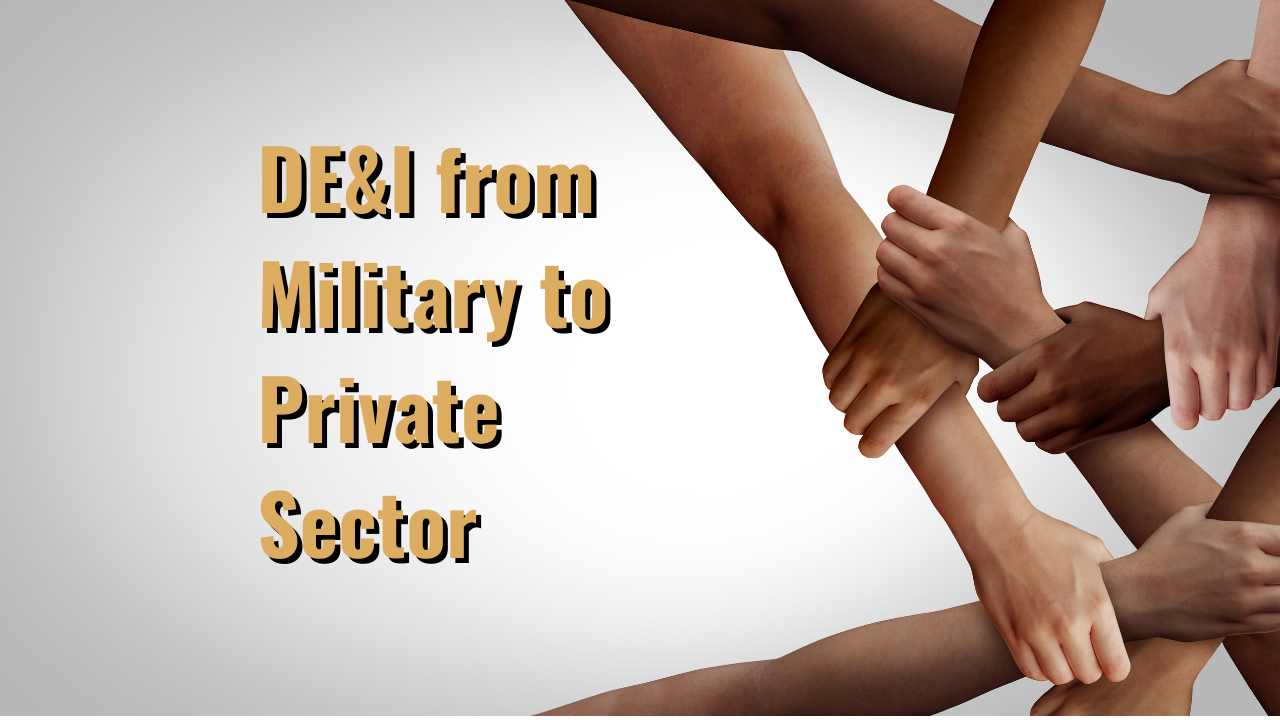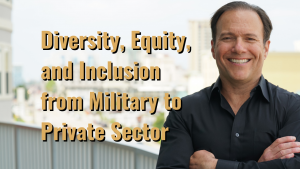
DE&I from Military to Private Sector

Given the recent report that the US Navy is not battle-ready but is 100% trained in DE&I initiatives, I am compelled to share my DE&I experience during my 26-year career in US Navy Special Operations as a Deep Sea Diver, and Explosive Ordnance Disposal (EOD Technician) contrasted against what I see and experience as a private sector business owner.
Over the past decade, and certainly, this past year, given the George Floyd incident among others, the initiative of diversity, equity, and inclusion (DE&I) has gained renewed focus. Working toward improved DE&I is an inherent element of being a good leader—it simply makes sense. If you think you are already being inclusive, chances are you have good foundational principles in place. If you are feeling a bit ambivalent as we approach this discussion, rest assured you are not alone.
In addition to the timeliness of the topic for our nation, it has been a significant evolution for me as a leader, bringing my prior military experiences and expectations related to DE&I into the private sector. As an enlisted servicemember for 16 years, then as a commissioned officer for 10 years, my perspective on building and leading teams evolved. We made sure we paid attention to each other as teammates. The Navy’s core values of honor, courage, and commitment apply to the ship, shipmates, and self in that order, and we swear an oath to uphold these values. Although these are not referred to as elements of DE&I, upon reflection I realized our core values are DE&I—in action. While it is not perfect, it is an excellent model and the most diverse and inclusive environment that I have ever been exposed to. How can you shape your business to infuse these values to advance DE&I? How can you make it your organization’s standard practice, informing everyday work?
In my current role within the business community, and as a community leader and public figure, I witness DE&I initiatives gaining traction daily as companies, communities, and government agencies develop and implement DE&I programming. I currently serve on the Hampton Roads Chamber of Commerce DE&I Committee, to develop DE&I initiatives that will further enable conditions for businesses to succeed and thrive. Certainly, DE&I can be difficult to get right, and I will admit that I am ambivalent regarding certain assumptions and beliefs coming from those who have been appointed as subject matter experts, but who may lack some critical boots-on-the-ground experiences in functional diversity and inclusion, as well as the business owner’s perspective. One of the tasks within the committee was to develop our working definitions of each of the three words that encompass DE&I. We reduced each of the definitions to one sentence, making them easier to understand and execute.
- Diversity: The characteristics that make individuals unique.
- Equity: The process of allocating resources, programs, and opportunities to employees, customers, and residents.
- Inclusion: The process of ensuring that every voice is heard, and all have a sense of belonging and are respected in the workplace, irrespective of their backgrounds.
DE&I in the Military
I am dedicated to a diverse and inclusive work environment. How does that look in 3D and 4K? I spent 26 years serving the world’s greatest Navy, and my experience, especially within Special Operations, was one of diversity and inclusion. The sailor or soldier next to me was my teammate…literally a brother or a sister. We would die for each other if we had to. The memory of the young and brave black, Hispanic, and other American women that I served with in Iraq will be with me forever. No matter what their job was in the military, these young warriors were there to fight alongside me if need be. They knew it and so did I. For example, the admin clerk had a loaded weapon at her side while doing paperwork. She was trained and ready to use that weapon if necessary. Even before and after my time in the war zone, my experience with DE&I within the military was based on the core values of the services. The Navy and Marine Corps, for example, hold fast to the core values of honor, courage, and commitment. The Army’s core values are loyalty, duty, respect, selfless service, honor, integrity, and personal courage. The Air Force’s core values are Integrity First, Service before Self, and Excellence In All We Do. General Ryan, USAF Ret., elaborates on these core values as follows:
“Core Values help those who join us to understand right from the outset what’s expected of them. Equally important, they provide all of us, from [the rank of] Airman to four-star general, with a touchstone—a guide in our own conscience—to remind us of what we expect from ourselves. We have wonderful people in the Air Force. But we aren’t perfect. Frequent reflection on the core values helps each of us refocus on the person we want to be and the example we want to set.” —General Michael E. Ryan, Chief of Staff, United States Air Force (CSAF), 1997-2001
The US military has codified a set of core values that are constantly reinforced, and which reinforce the standards for interpersonal actions. Through this experience, DE&I has become part of my DNA. Is this adherence to common core values possible in society, writ large? To varying degrees, yes, but the outcome is somewhat dependent on early childhood experiences. We know that things like education and life experience add up to disparate lifelong trajectories. As I adhered to these values in establishing my business, I looked for ways that I could alter those trajectories for the better. For example, my management team developed programming within our community to work directly with disadvantaged school children. In a very deliberate way, my team is going above and beyond to open doors and inspire students, developing pride and confidence in the next generation.
Enough said? Nope.
DE&I in the Workplace
As positive as my experience has been with DE&I throughout my military life, there have been times when the outcome was less than ideal in the workplace in the private sector.
While I question the assertion of white privilege, I agree that it is more difficult for certain people to accomplish their objectives. As a business owner, my priority in hiring is moral and ethical character because with these traits, competency can be developed. An employee’s moral and ethical character, and competency, are not qualified by race, ethnicity, sexual orientation, and the many other diversity descriptors.
As an employer of 35 people who depend on me for their livelihood, I must make decisions that are in every teammate’s best interest. In other words, I see my business as an organism needing certain elements to thrive, and I propose that DE&I demands that we ensure all teammates have sufficient sunshine, water, and oxygen to flourish. If leaders can integrate DE&I fully in the workplace, the outcomes are fundamentally good for business. However, I have seen the topic of DE&I become mired in resistance because of how it is positioned in forums mainly because there is no widespread agreement on the definition and execution of DE&I. Universities have differing definitions as do federal and state, and municipal governments. DE&I is often restricted to skin color as I often hear or read about the needs of black and brown employees. Certainly, the DE&I initiative is born of the plight of blacks, Hispanics, and other racially oppressed groups, but as a leader who put DE&I to practical use while in uniform, I can attest first-hand that the true value to be realized from DE&I goes well beyond skin color. You may be asking, how is this accomplished?
Inclusivity Leads to Diversity
I propose that you focus on inclusivity first. This upends conventional thinking, but I believe it unlocks true diversity and equity. Put methods in place to ensure everyone’s voice can be heard, especially by the leaders within the organization. It has been my experience that the best ideas come from the front lines, your customer-facing teammates. Not every idea is good, but the good ones often come from engaged teammates who want to help the organization succeed. Ideally, this includes every single person, regardless of skin color, background or experience, ability, education, or training. Rely on your employees’ instincts and learn to be an empathetic listener.
A more inclusive organization has more room to maneuver. It is more innovative. It responds and adapts more quickly to changing demands, such as the COVID-19 pandemic we are living through as of this writing. It is more responsive to all the voices around your table. By truly seeing and hearing everyone, your organization becomes resistant to the structural barriers that prevent the promotion of the best ideas and people. What does this sound like? During an all-hands last week, I discussed how DE&I is owned by everyone in the organization. “As a point of entry for our continued conversation on DE&I, I want you to know two things: 1) you have a voice, and we want to hear what you have to say, and 2) we are who we are because of you, and for us to diversify as we grow, we need you to bring more people to the table.” Although it is incumbent on the leader to promote DE&I in the workplace, it is imperative that every team member act with inclusivity as well.
Learn more about our leadership offerings at our website…
Search our hashtags: #elevateyourleadership #robertpizzini